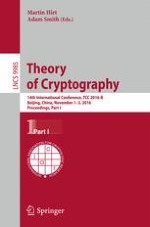2016 | OriginalPaper | Buchkapitel
Strong Hardness of Privacy from Weak Traitor Tracing
verfasst von : Lucas Kowalczyk, Tal Malkin, Jonathan Ullman, Mark Zhandry
Erschienen in: Theory of Cryptography
Verlag: Springer Berlin Heidelberg
Aktivieren Sie unsere intelligente Suche, um passende Fachinhalte oder Patente zu finden.
Wählen Sie Textabschnitte aus um mit Künstlicher Intelligenz passenden Patente zu finden. powered by
Markieren Sie Textabschnitte, um KI-gestützt weitere passende Inhalte zu finden. powered by
